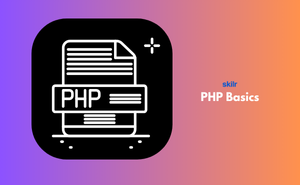👇 CELEBRATE CLOUD SECURITY DAY 👇
00
HOURS
00
MINUTES
00
SECONDS

PHP is a widely used scripting language designed to make websites more functional and engaging. Instead of a website only showing fixed content, PHP allows it to respond to users—for example, displaying account information after login or updating a shopping cart. Think of PHP as the invisible helper that keeps websites smart and interactive.
By studying PHP Basics, learners get introduced to the essential building blocks of web programming. This includes understanding how to write code that interacts with users and databases. These basics form a solid starting point for anyone interested in creating websites, web services, or stepping into a career in software development.
This exam is ideal for:
Domain 1 - Introduction to PHP
Domain 2 - PHP Basics
Domain 3 - Control Structures
Domain 4 - Functions in PHP
Domain 5 - Working with Forms
Domain 6 - Arrays in PHP
Domain 7 - Strings and String Functions
Domain 8 - PHP and Databases
Domain 9 - Error Handling & Debugging
Domain 10 - Basic PHP Security
Industry-endorsed certificates to strengthen your career profile.
Start learning immediately with digital materials, no delays.
Practice until you’re fully confident, at no additional charge.
Study anytime, anywhere, on laptop, tablet, or smartphone.
Courses and practice exams developed by qualified professionals.
Support available round the clock whenever you need help.
Easy-to-follow content with practice exams and assessments.
Join a global community of professionals advancing their skills.
IT services, e-commerce, education technology, startups, and digital agencies.
Anyone interested in learning website programming, including students, developers, or freelancers.
No, beginners can start directly with PHP Basics, though knowing HTML helps.
Definitely, it shows employers that you have foundational programming knowledge.
Yes, PHP Basics introduces MySQL integration for storing and retrieving data.
Yes, it helps web designers add coding ability to their creative work.
PHP continues to power many CMS platforms like WordPress, making it relevant.
Yes, it adds credibility and practical skills for job applications.
Yes, it builds programming logic that applies to other languages like Python or JavaScript.
Blogs, e-commerce sites, login systems, and simple web applications.
Absolutely, freelancers can use PHP to build client websites and applications.
Roles like Web Developer, Backend Developer, and PHP Programmer.
Yes, many websites and platforms still rely heavily on PHP for backend development.
Yes, it’s one of the most common starting points for web development careers.
Variables, loops, functions, forms, arrays, and database connections.